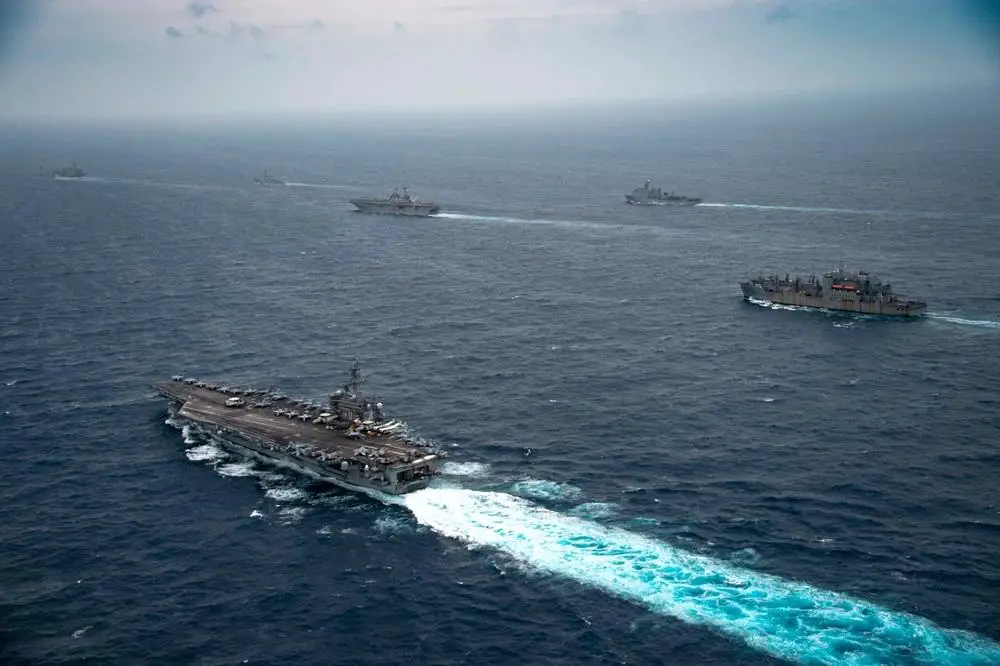Carl Vinson Carrier Strike Group (VINCSG) and Essex Amphibious Ready Group (ESX ARG) completed joint expeditionary strike force training operations in the South China Sea, January 16. The ESX ARG brings a host of Marine Corps air support to the operations including the “White Knights” of Marine Medium Tilt Rotor Squadron 165 (Reinforced) and the “Black Sheep” of Marine Attack Squadron (VMA) 214. The “White Knights” operate the MV-22B Osprey, UH-1Y Venom, AH-1Z Viper and the CH-53E Super Stallions while the “Black Sheep” operate the AV-8B Harrier. The training operations included integrated maritime strike missions, maritime interdiction operations, anti-submarine warfare, replenishment-at-sea and formation maneuvering/navigation operations. These operations are the latest events in strengthening naval readiness and interoperability in the Indo-Pacific region.
Our opportunity to conduct integrated operations with Carl Vinson Carrier Strike Group this past week showcases the U.S. Navy’s commitment to defending regional stability in the Indo-Pacific not only through our combined expertise and experience but through the differing capabilities of U.S. Navy big deck platforms,” said U.S. Navy Capt. Karrey Sanders, commodore of Amphibious Squadron (PHIBRON) 1.
“Our ability to quickly and effectively integrate with an amphibious ready group, such as ESX ARG, demonstrates a diverse level of naval lethality that is unlike any other naval force. The long-range strike capability of the Vinson Strike Group combined with the Essex ARG’s potential to deliver a payload of Marines to any maritime region greatly contributes to the U.S. strategic ability to continue defending a free and open Indo-Pacific.” said Rear Adm. Dan Martin, commander, Carrier Strike Group (CSG) 1.

The Essex Amphibious Ready Group (ESX ARG) is the first amphibious group to operate alongside the “advanced Air Wing of the Future” (CVW 2). CVW-2 is currently embarked aboard USS Carl Vinson (CVN 70). The advanced Air Wing of the Future includes the capabilities of the F-35C Lightning II, operated by the “Argonauts” of Strike Fighter Squadron (VFA) 147 and the CMV-22B Osprey, operated by the “Titans” of Fleet Logistics Multi-Mission Squadron (VRM) 30. Vinson, the flagship of VINCSG deployed in August 2021. The Essex Amphibious Ready group consists of PHIBRON 1 and the 11th Marine Expeditionary Unit (MEU). PHIBRON 1 ships operating alongside VINCSG in the South China Sea includes landing helicopter dock USS Essex (LHD 2) and amphibious dock landing ship USS Pearl Harbor (LSD 52). USS Essex (LHD-2) is a Wasp-class Landing Helicopter Dock (LHD) in service with the United States Navy. The amphibious assault ship was built at what is now Huntington Ingalls Industries in Pascagoula, Mississippi.
In October 2009, the US Navy announced that Carl Vinson would be the flagship of the newly established Carrier Strike Group One (CSG1), based in San Diego. The ship, under the command of then Captain Bruce H. Lindsey, departed Norfolk for San Diego on 12 January 2010. Accompanying the carrier was Carrier Air Wing Seventeen, Destroyer Squadron 1 and the guided missile cruiser Bunker Hill. Participating VINCSG units included aircraft carrier USS Carl Vinson (CVN 70), Ticonderoga-class guided-missile cruiser USS Lake Champlain (CG 57), and three Arleigh Burke-class guided missile destroyers of Destroyer Squadron (DESRON) 1: USS Michael Murphy (DDG 112), USS O’Kane (DDG 77), and USS Chafee (DDG 90). Additionally, nine squadrons of CVW-2 deployed aboard Vinson last August. USS Carl Vinson (CVN-70) is the United States Navy’s third Nimitz-class supercarrier. She is named for Carl Vinson, a Congressman from Georgia, in recognition of his contributions to the U.S. Navy. The ship was launched in 1980, undertook her maiden voyage in 1983, and underwent refueling and overhaul between 2005 and 2009.
















